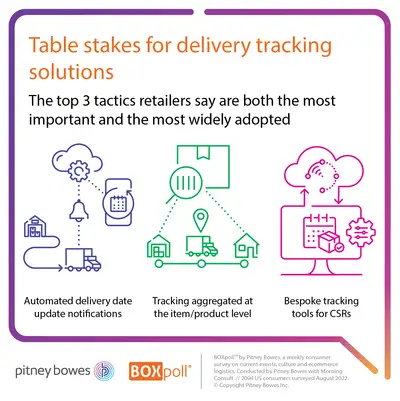Retailers’ top tracking priorities
Image caption: “cardboard box surrounded by arrows on a gps map, digital art.” Artwork by DALL-E / Courtesy OpenAI, edited by Pitney Bowes.
Delivery tracking is a highly mature and largely commoditized space with several dozen providers of tracking software, in addition to solutions offered by carriers themselves.
Given the maturity of this space, it can be difficult for retailers to identify what features are worth investing in, and which are emerging as the new “must-haves”—given that so many features can be considered “already haves.”
We presented 168 U.S. online retailers with a list of 12 tracking tactics and asked them (1) to rank the options in order of importance and (2) whether their business had adopted each feature.
We used the responses to put features into four buckets:
- Commodities (low importance, but widely adopted)
- Table stakes (highly important and widely adopted)
- Distractions (low importance and low adoption)
- Gold mines (highly important but not widely adopted)
It can be difficult for online retailers to identify which tracking features are worth investing in, and which are emerging as the new “must-haves”—given that so many features can be considered “already haves.”
All online retailers
Among all online retailers we surveyed, the top three “table stakes” tracking tactics are:
- Automated notifications to customers when delivery date changes
- Tracking at the SKU level across all orders/parcels
- Tracking tools for customer care reps

It makes sense to see tools that help internal visibility—like tracking at the SKU level and tracking tools for customer care reps—top the list. Retailers’ value of automated notifications for changing delivery dates is also hardly a surprise. We know from previous BOXpoll surveys revealing that companies can slash the number of calls to customer care by providing a revised estimated delivery date when a package is running late. (And on a more granular level, customers also appreciate updated delivery times—provided they don’t get more than one or two updates.)
Because we know ecommerce brands’ needs vary by business size, we also segmented responses by annual order volume.
Mid-market ecommerce brands
For mid-market retailers (which, for the purposes of this survey, we defined as brands with annual DTC ecommerce orders between 25K – 250K), the top three “table stakes” tracking features are:
- Using tracking as a marketing channel (featured promotions, email/SMS opt-ins, content distribution, etc.)
- Tracking at the SKU level (across all orders/parcels)
- Tracking tools for customer care reps
The key differentiating priority for mid-size brands is leveraging tracking as a marketing channel. A fixture of our Weekly Trackers since last spring, our BOXpoll surveys regularly ask consumers how often on average they check tracking information per online order. The responses have remained remarkably consistent: consumers check tracking an average 3.5 times per order. Younger shoppers look at tracking even more often, with Gen Z and Millennials checking an average of 5.6 and 4.4 times per order, respectively. Mid-market ecommerce brands have recognized the high level of interest in tracking as an opportunity for customer engagement and cross-selling promotions.
On the other side of the importance/adoption map, the features with the lowest importance—compared to the other options surveyed—and lowest adoption rates are:
- Customizable branding/design for tracking pages/emails
- Aggregated tracking at truck/container level
- Ability to intercept a parcel enroute and redirect it to an alternate delivery location (e.g., pickup)
While we were initially a bit perplexed to see customized branding for tracking pages and emails on this list, we suspect the forced ranking format of the survey question plays a role here. Presented with “use tracking for marketing” and “use branded tracking pages and emails” as separate options, respondents likely viewed the latter as less valuable as a standalone option. Using tracking as a marketing opportunity– which mid-market brands say is one of their top priorities—requires branded tracking. However, it’s possible—albeit less valuable—to have branded tracking without taking advantage of marketing mileage.
Enterprise ecommerce brands
For enterprise retailers (brands with annual DTC ecommerce order volumes of more than 250K), the top three “table stakes” tracking features are:
- Notifications (via email/SMS) to customers based on tracking events
- Multicarrier tracking (single customer experience across all carrier deliveries)
- Tracking tools for customer care reps
The capability to send email/SMS notifications to customers based on tracking events, which may be a luxury for smaller brands, is highly important to enterprise retailers.
As multicarrier strategy remains top of mind for retailers in 2022—especially larger brands under more pressure to diversify their carrier base—a consistent customer tracking experience, no matter the carrier, is a top priority.
The features with the lowest importance and lowest adoption rates among enterprise brands are:
- Aggregated tracking at truck/container level
- Customizable branding/design for tracking pages/emails
- Integration of tracking into their email/loyalty marketing platform
BOXpoll™ by Pitney Bowes, a weekly consumer survey on current events, culture, and ecommerce logistics. Conducted by Pitney Bowes with Cipher Research // 168 US online retailers surveyed February 2022. © Copyright Pitney Bowes Inc.
